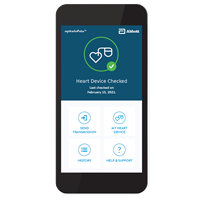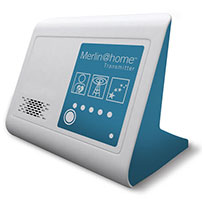Manage your device ID Card
Keep your ID card information updated so you can always get the best care possible when you need it.
A cardiac resynchronization therapy (CRT) device is a small, implantable device that helps bring your heartbeat back into sync.1 Understanding how it works is a little complicated, so let’s break it down.
The two lower chambers of your heart (also known as the ventricles) and the CRT device work as a team to keep your heart properly pumping. Think of those lower two chambers as two separate teammates who must squeeze together in sync. This synchronized squeezing is called ventricular synchrony.
Sometimes though these teammates struggle to communicate, and they start to work independently, so their once-synchronized squeezing becomes out of sync. This is called ventricular dyssynchrony.
They need a heart coach to bring them together. A CRT device is that coach. It gives the two chambers a tap via an electrical pulse. This action synchronizes the two chambers, allowing them to once again act as a team to effectively pump blood to your entire body so you can continue your normal activities.
The heart is powered by a complex, natural electrical system that helps it maintain a healthy rhythm while pumping blood throughout the body.
Heart failure is when the lower chambers of the heart (the ventricles) are unable to effectively pump blood to the entire body. You might have shortness of breath or be extremely tired. If you have moderate-to-severe (or chronic) heart failure your doctor might recommend a CRT device.2
There are the two types of CRT devices, depending on your heart condition:2,3
Heart failure is a chronic, progressive disease. Early use of a CRT device can actually help reverse some of the damage to your heart caused by heart failure. Studies show that CRT devices can improve one’s energy and quality of life.2
The CRT device also stores information about your heart rhythm. Based on this information, your doctor may adjust the settings of your CRT device to best meet your needs.
We want you to enjoy more of life’s moments each day, uninterrupted. That’s why our CRT solutions are designed with exclusive algorithms to seamlessly monitor and manage an irregular heartbeat.
There are more ways to allow you to live life to the fullest. Remote monitoring of your Abbott implanted CRT heart device may help you do just that, and it gives you and your doctor the feeling of safety and security of continuous monitoring of your heart from the time of implant to the time you are at home.
With remote monitoring, your CRT device is able to communicate to your doctor's office or clinic without you having to go in for an in-person visit. Your doctor may schedule your in-person visits less frequently, based on the data they receive from your device.
After your CRT device is implanted, you will use either a transmitter or downloadable mobile app to transmit information to your doctor.
The myMerlinPulse™ Mobile App works with Abbott’s next generation Gallant™ and Entrant™ CRT devices. The app can automatically or manually (as requested) collect relevant data from your implanted heart device and send it to your doctor or clinic.

Certain Abbott CRTs work with the Merlin@home™ Transmitter. This transmitter syncs with your CRT device and collects data about your heart’s activity. Device and cardiac activity are monitored, and the data is shared with your doctor or clinic.



Rx Only
Brief Summary: Prior to using these devices, please review the User’s Manual for a complete listing of indications, contraindications, warnings, precautions, potential adverse events and directions for use.
CRT-D Indications: The Cardiac Resynchronization Therapy (CRT) devices are indicated for reduction of symptoms in patients who have congestive heart failure, a reduced left ventricular ejection fraction (LVEF) and a prolonged QRS duration. CRT-D devices are indicated in patients who meet the CRT indications and have already survived a cardiac arrest or are at a high risk of Sudden Cardiac Death (SCD) due to VT (ventricular tachycardia) or VF (ventricular fibrillation). The device is most commonly implanted within a device pocket in the pectoral region. Contraindications: Contraindications for use of the pulse generator system include ventricular tachyarrhythmias resulting from transient or correctable factors such as drug toxicity, electrolyte imbalance, or acute myocardial infarction. Adverse Events: Possible adverse events associated with the implantation of the pulse generator system include the following: Arrhythmia (for example, accelerated or induced), Bradycardia, Cardiac or venous perforation, Cardiac tamponade, Cardiogenic shock, Death, Discomfort, Embolism, Endocarditis, Erosion, Exacerbation of heart failure, Excessive fibrotic tissue growth, Extracardiac stimulation (phrenic nerve, diaphragm, pectoral muscle), Extrusion, Fluid accumulation within the device pocket, Formation of hematomas, cysts, or seromas, Heart block, Hemorrhage, Hemothorax, Hypersensitivity, including local tissue reaction or allergic reaction, Infection, Keloid formation, Myocardial damage, Nerve damage, Occlusion/Thrombus, Pericardial effusion, Pericarditis, Pneumothorax, Pulmonary edema, Syncope, Thrombosis, Valve damage. Complications reported with direct subclavian venipuncture include pneumothorax, hemothorax, laceration of the subclavian artery, arteriovenous fistula, neural damage, thoracic duct injury, cannulation of other vessels, massive hemorrhage and rarely, death. Among the psychological effects of device implantation are imagined pulsing, depression, dependency, fear of premature battery depletion, device malfunction, inappropriate pulsing, shocking while conscious, or losing pulse capability. Possible adverse device effects include complications due to the following: Abnormal battery depletion, Conductor fracture, Device-programmer communication failure, Elevated or rise in defibrillation/cardioversion threshold, Inability to defibrillate or pace, Inability to interrogate or program due to programmer or device malfunction, Incomplete lead connection with pulse generator, Inhibited therapy including defibrillation and pacing, Inappropriate therapy (for example, shocks and antitachycardia pacing [ATP] where applicable, pacing), Interruption of function due to electrical or magnetic interference, Intolerance to high rate pacing (for example dyspnea or discomfort), Lead abrasion, Lead fracture, Lead insulation damage, Lead migration or lead dislodgement, Loss of device functionality due to component failure, Pulse generator migration, Rise in DFT threshold, Rise in pacing threshold and exit block, Shunting of energy from defibrillation paddles, System failure due to ionizing radiation. Additionally, potential adverse events associated with the implantation of a coronary venous lead system include the following: Allergic reaction to contrast media, Breakage or failure of implant instruments, Prolonged exposure to fluoroscopic radiation, Renal failure from contrast media used to visualize coronary veins.
No potential adverse events have been identified with use of the myMerlinPulse™ mobile application.
CRT-P Indications/Intended Use: Implantation of a Cardiac Resynchronization Therapy Pacemaker (CRT-P) is indicated for: maintaining synchrony of the left and right ventricles in patients who have undergone an AV nodal ablation for chronic atrial fibrillation and have NYHA Class II or III heart failure; the reduction of the symptoms of moderate to severe heart failure (NYHA Class III or IV) in those patients who remain symptomatic despite stable, optimal medical therapy, and have a left ventricular ejection fraction ≤35% and a prolonged QRS duration. Implantation is indicated in one or more of the following permanent conditions, or any combination of these symptoms: syncope, presyncope, fatigue, disorientation. Rate-modulated pacing is indicated for patients with chronotropic incompetence, and for those who would benefit from increased stimulation rates concurrent with physical activity. Chronotropic incompetence has not been rigorously defined. A conservative approach, supported by the literature, defines chronotropic incompetence as the failure to achieve an intrinsic heart rate of 70% of the age-predicted maximum heart rate or 120 bpm during exercise testing, whichever is less, where the age-predicted heart rate is calculated as 197 — (0.56 x age). Dual-chamber pacing is indicated for those patients exhibiting: sick sinus syndrome; chronic, symptomatic second- and third-degree AV block; recurrent Adams-Stokes syndrome; symptomatic bilateral bundle branch block when tachyarrhythmia and other causes have been ruled out. Atrial pacing is indicated for patients with sinus node dysfunction and normal AV and intraventricular conduction systems. Ventricular pacing is indicated for patients with significant bradycardia and: normal sinus rhythm with only rare episodes of AV block or sinus arrest, chronic atrial fibrillation, severe physical disability. AF Suppression™ algorithm stimulation is indicated for suppression of paroxysmal or persistent atrial fibrillation episodes in patients with one or more of the above pacing indications. Contraindications: Devices are contraindicated in patients with an implanted cardioverter-defibrillator. Rate-adaptive pacing may be inappropriate for patients who experience angina or other symptoms of myocardial dysfunction at higher sensor-driven rates. An appropriate Maximum Sensor Rate should be selected based on assessment of the highest stimulation rate tolerated by the patient. AF Suppression™ algorithm stimulation is not recommended in patients who cannot tolerate high atrial-rate stimulation. Dual-chamber pacing, though not contraindicated for patients with chronic atrial flutter, chronic atrial fibrillation, or silent atria, may provide no benefit beyond that of single-chamber pacing in such patients. Single-chamber ventricular demand pacing is relatively contraindicated in patients who have demonstrated pacemaker syndrome, have retrograde VA conduction, or suffer a drop in arterial blood pressure with the onset of ventricular pacing. Single-chamber atrial pacing is relatively contraindicated in patients who have demonstrated compromise of AV conduction. For specific contraindications associated with individual modes, refer to the programmer's on-screen help. Adverse Events: The following are potential complications associated with the use of any pacing system: air embolism; body rejection phenomena; cardiac tamponade or perforation; hematoma, bleeding hematoma, seroma; formation of fibrotic tissue, local tissue reaction; inability to interrogate or program due to programmer or device malfunction; infection; erosion; interruption of desired pulse generator function due to electrical interference, either electromyogenic or electromagnetic; lead malfunction due to conductor fracture or insulation degradation; loss of capture or sensing due to lead dislodgement or reaction at the electrode/tissue interface; loss of desired pacing and/or sensing due to lead displacement, body reaction at electrode interface, or lead malfunction (fracture or damage to insulation); loss of normal device function due to battery failure or component malfunction; pacemaker migration or pocket erosion; pectoral muscle or diaphragmatic stimulation; phrenic nerve stimulation; pneumothorax/hemothorax; device migration and pocket erosion; endocarditis; excessive bleeding; induced atrial or ventricular arrhythmias; myocardial irritability; pericardial effusion; pericardial rub; pulmonary edema; rise in threshold and exit block; valve damage; cardiac/coronary sinus dissection; cardiac/coronary sinus perforation; coronary sinus or cardiac vein thrombosis, death.
Refer to the User’s Manual for detailed indications, contraindications, warnings, precautions and potential adverse events.
MAT-2115398 v3.0
Stay Connected